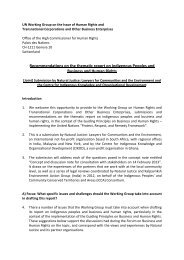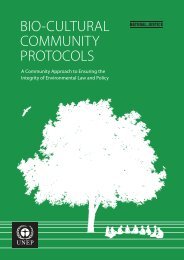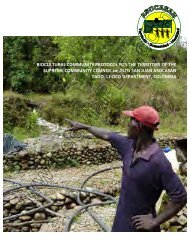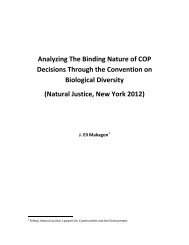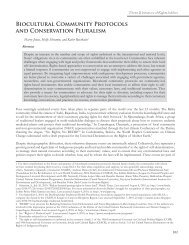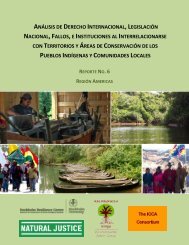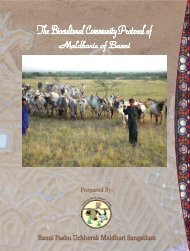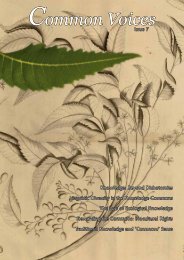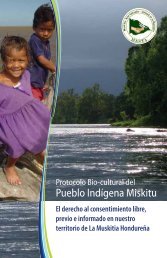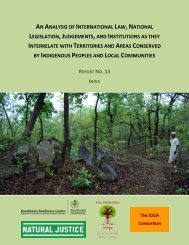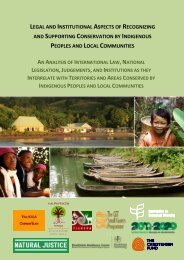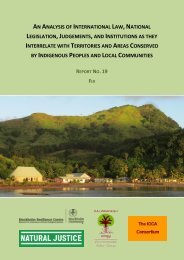Engaging with Diverse Biocultural Realities - Natural Justice
Engaging with Diverse Biocultural Realities - Natural Justice
Engaging with Diverse Biocultural Realities - Natural Justice
- No tags were found...
Create successful ePaper yourself
Turn your PDF publications into a flip-book with our unique Google optimized e-Paper software.
21Will the Flamingos Return to the Fishing Shelters?<strong>Engaging</strong> <strong>with</strong> <strong>Diverse</strong> <strong>Biocultural</strong> <strong>Realities</strong>Kanchi Kohli1. Locating the Loss“Surkhaab (flamingoes),” said a fisherman, “were very few this year. Perhaps next year will bebetter,” he added hopefully.“Where are you off to <strong>with</strong>out your fishing boat, brother?” I asked <strong>with</strong> a smile, receiving amatter-of-fact response in return.“Pagadiya (on foot fishing),” he said, “and I will be back <strong>with</strong> some fish to cook; will you bestaying to eat <strong>with</strong> us?”We were at Randh Bander, talking to the last few fishing families heading towards their mainvillage for a community festival. The Randh was where their temporary fishing shelters and fishdrying areas were located. Smiles surrounded the sunset at this traditional fishing harbour, andconversations came as easily to them as mending nets, anchoring boats, and bringing in smallfish catch for dinner.This unique landlocked inter-tidal area of Bhadreshwar is considered to be the second-largestfish production centre on the coast of the ecologically fragile Kutch district in the western Indianstate of Gujarat. It is estimated that nearly 6000 fisherfolk from Bhadreshwar, Luni, Tuna,Sangad, and other adjoining villages have been using the Bander for traditional fishing for over200 years. Boat fishing is carried out up to 10 kilometres (km) from the coast and pagadiya (onfoot) fishing is carried out on a 10-km stretch along the coast (5 km on each side of the Bander).Figure 1: Flamingos near a fishing harbour in Bhadreshwar. © Kanchi Kohli
26current rate of biodiversity loss by 2010 at the global, regional, and national levels as acontribution to poverty alleviation and for the benefit of all life. In 2010, although this targetwas not achieved, the Parties to the CBD adopted the Aichi Biodiversity Targets, <strong>with</strong> strategicgoals to reduce biodiversity loss by the year 2020. This vision once again aims to reduce directpressures on biodiversity and promote use that improves the status of biodiversity bysafeguarding ecosystems, species, and genetic diversity. Yet as noted above, despite theselaudable targets, the third GBO clearly articulates the increasing pressures on biodiversity andits worsening decline.Many country assessment reports also add detail to these trends. For instance, the 2007Addendum to the Biodiversity Conservation in Sri Lanka: A framework for Action submitted tothe CBD in 1998 clearly states that biological diversity of that country has been lost due to arange of factors. These include habitat loss resulting from fragmentation, invasive alien species,unsustainable harvesting of resources, pollution of the soil, water, and atmosphere,desertification, global warming and climate change, and unregulated industrialisation andeconomic development. 7The incumbent question is: why is it that, despite a wide range of legal instruments and policydirectives, ecosystems and local ways of life across Asia continue to be under the threat ofoveruse and degradation? 8 Our response needs to go beyond the rhetoric of good laws notbeing implemented. Instead, it is critical to delve deeper into how the design of legal and policyframeworks have been successfully transformed to facilitate the progression of industrialexpansion and commercial use of biological and natural resources. The other question thatbears scrutiny is whether the above inadequacy is partly due to the fact that communities havefelt largely disconnected from these legal frameworks, or because their customary practiceshave not found place in present-day legal and policy frameworks.It is seldom that proposals by people’s movements and NGOs are accepted in toto by actors inthe decision-making arena. It is not uncommon today to see the same problem sought to beaddressed in different ways in conservation and industrialisation debates. For instance, if loss ofbiodiversity or threats is attributed entirely to anthropogenic pressures of local communities,then the answers are presented in the creation of enclosures aimed at reducing these pressures(such as protected areas and policy measures to stop shifting cultivation practices). However, ifthe underlying problem is the loss of forests, wetlands, and coastal spaces because of largescaleindustrial expansion, then the solution lies in reducing those pressures. As highlightedearlier, rather than isolating communities from the habitat, this approach instead requiresmechanisms that allow for devolution of powers to the Indigenous peoples and localcommunities who are the custodians of their territories, landscapes, and seascapes.7 Ministry of Environment and <strong>Natural</strong> Resources, 2007. Biodiversity Conservation in Sri Lanka: A framework forAction. Biodiversity Secretariat, Ministry of Environment and <strong>Natural</strong> Resources: Colombo.8 Jonas, H., J. E. Makagon, and H. Shrumm, 2013. The Living Convention: A Compendium of InternationallyRecognized Rights that Support the Integrity and Resilience of Indigenous Peoples’ and Local Communities’Territories and other Social-ecological Systems. <strong>Natural</strong> <strong>Justice</strong>: South Africa and Malaysia.
27Beyond the flawed way that policy-makers approach the law, there are a number of factorsrelated to the challenges faced by Indigenous peoples and tribal and local communities whenengaging <strong>with</strong> laws and institutions. 9 Four in particular have ramifications for communitiesseeking to assert their rights to self-determination and wellbeing.The first relates to the information gap suffered by many communities in Asia who are simplyunaware of the rights and responsibilities being decided at the international and national levels;few efforts are made by national governments and international agencies to bridge thisknowledge gap. This inability to ‘reach up’ to realise their rights compounds the inefficientimplementation of laws that do support Indigenous peoples’ and local communities’ selfdetermination.Second, laws compartmentalise the otherwise interdependent aspects of biocultural diversityby drawing legislative borders around them and addressing them as distinct segments. Whilecommunities manage integrated landscapes, 10 the State tends to view each resource andassociated traditional knowledge through a narrow lens, implementing corresponding lawsthrough agencies that separately address, for example, biodiversity, forests, agriculture, andIndigenous knowledge systems. The result is that communities’ lives are disaggregated in lawand policy, which effectively fragments their claims to self-determination into specific issuerelatedsites of struggle.Third, law affects the very nature of whom or what is defined as ‘community’. In general, peoplehave a variety of ways of establishing who is a member of a family or community and who is anoutsider. Communities may define themselves in a number of different ways and in differentcontexts, based on multiple factors such as heritage, ethnicity, language, geographical proximity,and shared resources or knowledge. 11 State law, however, is insensitive to local, adaptiveconceptions of community and tends to impose an over-generalised and homogeneousclassification as a static and rigidly defined entity. This contradicts local realities and can furtherdivide and weaken local institutions and social structures. 12Fourth, positive law (both international and State) may conflict <strong>with</strong> the customary laws thatgovern communities’ sustainable use of natural resources. 13 For example, the understanding of‘property’ under positive law is based on the private rights of a person (human or corporate) to9 The four challenges are drawn from Jonas H., H. Shrumm, and A. Kothari, 2012. Legal and Institutional Aspects ofRecognizing and Supporting Conservation by Indigenous Peoples and Local Communities: An Analysis ofInternational Law, National Legislation, Judgements and Institutions as they Interrelate <strong>with</strong> Territories and AreasConserved by Indigenous Peoples and Local Communities. <strong>Natural</strong> <strong>Justice</strong> and Kalpavriksh: Bangalore and Pune.10 Watson, A., L. Alessa, and B. Glaspell, 2003. “The Relationship Between Traditional Ecological Knowledge,Evolving Cultures, and Wilderness Protection in the Circumpolar North”. Conservation Ecology, 8(1): 2-15.11 Agrawal, A., and C. C. Gibson, 1999. “Enchantment and Disenchantment: The Role of Community in <strong>Natural</strong>Resource Conservation”. World Development, 27(4): 629-649.12 Bosch, D., 2003. “Land Conflict Management in South Africa: Lessons Learned from a Land Rights Approach”. Lastaccessed August 4, 2010, at: http://www.fao.org/docrep/006/j0415t/j0415t0a.htm.13 Cotula, L., and P. Mathieu (eds.), 2008. Legal Empowerment in Practice, Using Legal Tools to Secure Land Rights inAfrica. IIED: London, United Kingdom.
28appropriate and alienate physical and intellectual property. In contrast, communities’ propertysystems in a specific context can be relational and entail collective ownership of resources. Thishas been illustrated earlier from examples in Niyamgiri and Bhadreshwar and is true of manyparts of Asia. Furthermore, the implementation of positive law can overpower and contravenecustomary law. A system that denies legal pluralism has direct impacts on communities’ lives,for example, by undermining the cultural practices and institutions that underpin sustainableecosystem management. 14These four challenges, among others, highlight the fact that the imposition of international andnational environmental laws, which are inherently fragmentary and based on staticmisperceptions of local realities, has the potential to undermine the interconnected andadaptive systems that underpin biocultural diversity. The net result is that communities’ abilityto use the laws that support their role as custodians of biodiversity is undermined. 15 The nextsection looks more closely at these dynamics as they manifest themselves at the national andlocal levels.2. Driving the LossDrawing on the above section, two parallel streams of thought are well-established inbiodiversity-centric policy and legal debates today. First, ecological systems and biodiversityhave been under threat for several decades. While natural processes might be impacting thesefor generations, the extent of damage has been expedited due to various kinds of humanintervention. These have been largely driven by an economic growth impetus that relies on aform of industrial expansion that requires the commercialisation and privatisation of geneticand biological material and natural elements such as water, land, and even air.Secondly, it is increasingly acknowledged that natural ecosystems are not devoid of the peoplewho depend on them. The human and the wild live at a respectful distance at times and comein conflict at others. However, no use of or extraction from these ecosystems is devoid ofimpacts. Thus the central debate now is about which forms of governance regimes best locatethe powers to determine access to and continuation of human-biodiversity relationships.The lessons lie in understanding the kind of solutions that are being brought forth to deal <strong>with</strong>both human and ecological loss. Are the loss of biodiversity, degradation of environment, andsubsequent impacts on biodiversity-based livelihoods and cultures inevitable trade-offs in thenational or global project of industrial expansion? The nature, form, and extent of such tradeoffswill differ depending on the exact motivations that are driving use of biodiversity and14 Sheleef, L., 2000. The Future of Tradition: Customary Law, Common Law and Legal Pluralism. Frank Cass: London,England, and Portland, Oregon.15 Porter-Bolland, L., E. Ellis, M. Guaringuata, I. Ruiz-Mallen, S. Negrete-Yanklevich, and V. Reyes-Garcia, 2012.“Community managed forests and forest protected areas: An assessment of their conservation effectiveness acrossthe tropics”. Forest Ecology and Management, 268: 6-17.
29related knowledges. Another critical question is: how much community-level logics andwisdoms (if any) will decision-makers take on board in policy and legal design? Moreover, indoing so, who do they consider ‘experts’ and whose word will count when it comes todetermining future actions?Figure 3: Intertidal area of Randh Bander, which has been the site of resistance against a thermal power plant inBhadreshwar, Kutch. © Kanchi KohliThe sections below attempt to look at both endogenous and exogenous factors that might beinfluencing decisions <strong>with</strong> or <strong>with</strong>out the knowledge of impacts that may follow. They alsoexplore the fact that no matter how convinced Indigenous peoples and local communities mightbe that their biocultural ethos is secure, they might not be able to maintain existing bioculturalrelationships if the externalities are not brought into check. The determination of states toindustrialise, the creation of a deep corporate-state-political nexus, and internal splinters <strong>with</strong>incommunities are critical factors driving the loss of biodiversity. <strong>Biocultural</strong> relationships cannotsurvive where national growth logics undermine them and where communities choose toprioritise consumptive values.
302.1. National Growth LogicsThe endogenous growth theory holds that internal policy measures impact the growth rate ofan economy. Driving the development of national policy are political decisions arounddetermining the use of natural resources. These decisions often ignore the range of impactsthat can be foreseen or pre-empted from earlier experiences of large-scale industrial processesand related infrastructure development.In 1955, India’s first Prime Minister stated that “[India’s] goals can only be achieved by aconsiderable increase in national income and our economic policy must, therefore, aim at plentyand equitable distribution. We must produce wealth, and then divide it equitably. How can wehave a welfare state <strong>with</strong>out wealth?” At that time, the sentiment might have been anaspiration fitting a brand-new socialist democracy emerging from over four centuries of colonialrule. However, this quote was recycled more recently by the Indian Finance Minister during hispresentation of the country’s budget for 2008-2009. Today, this statement symbolises ‘businessas usual’; growth and accumulation of wealth are taken for granted as central goals in thecountry. It is also believed that the country’s land, water, ecological spaces, and biodiversityshould be used ‘optimally’ for economic growth. To achieve this, new partnerships <strong>with</strong> theprivate sector and multilateral agencies are encouraged, and mammoth investments are to beinvited at all social and environmental costs. 16Like many Asian countries, India is pushing its agenda to achieve double-figure growth ratestowards its goal of becoming a global superpower as well as to address the challenge posed byfast-growing neighbouring countries like China. 17 As First Deputy Managing Director of theInternational Monetary Fund, David Lipton, stated in a speech at the Asian Financial Forum inHong Kong in early 2012, Asia emerged from the 2008 financial crisis <strong>with</strong> its global economicstanding strengthened. Asia, he said, “is headed toward becoming the largest economic regionin the world over the next two decades”. 18 However, this drive towards economic growth is notdevoid of direct impacts on the people and the ecosystems they intricately depend upon. Theexamples provided below illustrated how the use and misuse of laws today abets this process.The decision taken by India’s Ministry of Environment and Forests (MoEF) for the granting ofenvironmental approvals for setting up a nuclear power plant at Jaitapur at Ratnagiri district inthe state of Maharashtra was not <strong>with</strong>out recognising the biodiversity importance or thefisheries-dependent communities in the area. Other economic and political considerations alsohad important bearing on whether the plant would be viable from a social-ecological16 Kohli, K., and M. Menon, 2009a. “Liberalisation and environmental legislation in India”, pages 97-109 in PerryKessaris, A. (ed.), Law in the Pursuit of Development Principles into Practice? Routledge-Cavendish: United Kingdom.17 Despite the fact that the expansion in the world’s second-largest economy was the slowest in two-and-a-halfyears, it continues to be one of the reckoners on global growth maps and pose challenges for India’s economicpursuits. The Associated Press, 17 January, 2012. “China’s growth lowest in 2 years”. Last accessed 23 May, 2013,at: http://www.cbc.ca/news/business/story/2012/01/17/china-economy.html.18 Clift, J., 2012. “India and China: Asia’s Giants Discuss Way Forward”. Last accessed 27 March, 2013, at:http://www.imf.org/external/pubs/ft/survey/so/2012/new031612a.htm.
32persist, 22 what has evolved at various points is the meaninglessness of legal requirements in theface of strategic economic and political goals.2.2. International Trade PressuresIn addition to in-country processes, several international processes act as crucial externalinfluences, often challenging the manner in which biodiversity and human populations havebeen historically juxtaposed. While national governments both welcome and encourage theseinterventions, they are not devoid of their conflicts <strong>with</strong> existing local realities. Push-factorsfrom industrialised worldviews thus have a significant role to play in determining land use andaccess to resources, as well as shaping enabling regulations.The European Union (EU) is the largest trading bloc in the world and a free trade agreement(FTA) <strong>with</strong> India will be EU’s biggest thus far, if and when the text is agreed upon. 23 In 2004, theEU ‘upgraded’ its relations to make India a strategic partner. As of 2011, as part of the newtrade policy for the Europe 2020 strategy, 24 the European Commission intends to further focuson India to remove for itself obstacles to better functioning markets. Researchers like ShaliniBhutani have pointed out that such agreements are more than just about trade. They not onlydetermine what a country can import or export and on what terms, but also influence domesticpolicy-making in areas of investments, government procurement, and intellectual propertyrights. 25A recent briefing paper on the right to food points to several impacts that a bilateral FTA <strong>with</strong>the EU is likely to have on India. 26 In the section on land-related impacts on rural communities,the paper argues that despite the fact that foreign companies are not allowed to directlypurchase land in India, Foreign Direct Investment is allowed and promoted in sectors whereactivities often require a lot of land to build upon or from where ore can be extracted forproduction or export purposes. European investments have largely been increasing in sectorssuch as the automobile industry, agrofuel, solar and wind energy, and mining and minerals. 27Such deals are likely to commit national governments to procure and secure land on behalf ofcompanies and weaken or circumvent laws and regulations to aid this process. It comes as no22 Wadke, R., 8 October, 2011. “Villagers petition Green Tribunal to cancel approval for Jaitapur n-project”. TheHindu Business Line; and Press Trust of India, 16 May, 2011. “Protesters set up tribunal over Jaitapur issue”, DNA-Daily News and Anaysis, New Delhi.23 The EU and the Government of India were aiming to conclude the agreement by February, 2012, but there arereportedly further delays to its finalisation. See Hindu Business Line, 23 January, 2012. “India-EU FTA will not beinked at Delhi Summit: Envoy”. The Hindu Business Line.24Europa, 2011. “Trade policy serving the Europe 2020 strategy”. Last accessed 23 May, 2013, at:http://europa.eu/legislation_summaries/employment_and_social_policy/eu2020/em0043_en.htm.25 Bhutani, S., 2011. The India-EU FTA and its Implications on India’s Food and Farm Sector. Madhyam FactsheetNo.1, 2011: New Delhi.26 Misereor, Heinrich Böll Foundation, Third World Network, Anthra, and Glopolis, 2011. Right to Food ImpactAssessment of the EU-India Trade Agreement. Misereor, Heinrich Böll Foundation, Third World Network, Anthra,and Glopolis: Aachen, Berlin, Penang, Secunderabad, and Prague.27 Misereor et al., 2010.
33surprise then that many of these sites of large-scale industrial intervention are thentransformed into sites of local resistance.While the EU-India FTA is a case in point, there are investment scenarios from other Asiancountries already playing themselves out as examples of the ramifications of bilateralagreements. In 2005, the state government of Odisha in India was promised a range of benefitswhen it entered into a Memorandum of Understanding <strong>with</strong> the South Korean corporation M/sPohang Steel Company (POSCO). In return, assurances included that the state governmentwould facilitate all clearances and approvals of the Central Government, if required. Further,they would acquire and transfer all of the land required for the project and keep the area freefrom all encumbrances.The resistance against setting up of a steel plant, captive port, and related infrastructure byPOSCO has been one of the foremost people’s movements in India for the last eight years. Theland acquisition notices by the district administration were served as early as November, 2005.However, all attempts of the local state and company officials were stalled once the area wasbarricaded for entry. What has followed are myriad stories of repression, attempts atsuppression, negotiation, and a stiff battle for the right to life and locally-based livelihoods. 28While the official figure of the number of families being affected is quoted as “up to 400”,according to the local leaders of the movement against the POSCO project, the entirepopulation of 22,000 will be affected due to displacement of livelihoods based on a thrivingagricultural economy. Apart from paddy cultivation, the most critical livelihood support isprovided by the cultivation of paan or betel leaf, which generates substantial income for thecommunities living in the area. Cashew nut cultivation and pisciculture (fish breeding) are alsoimportant livelihood sources. The proposed port at Jatadhari (Estuarine region of Ersamma)would also directly displace the livelihoods of several fishing communities, as the Jatadhariestuary serves as a spawning and breeding ground for several species of fish. It will also causeirreversible damage to the coastline. 29 While legal and procedural formalities have repeatedlygone in favour of the company, the ongoing struggle to protect homes, livelihoods, and lifesystems continues to challenge POSCO’s entry, despite it having the support of the highestoffices in Government of India. 30 These offices have continuously intervened to speed updecisions at both rungs of the federal structure. Visits of mutual cooperation between the twocountries have at various points of time sent speculations around the implications they wouldhave for the POSCO project in Odisha. 31 The Prime Minister of India has consistently andpublicly indicated his support for the project despite a seven-year resistance at the project site.28 Mining Zone People’ s Solidarity Group, 2010. Iron and Steal: The POSCO-India Story. Mining Zone People’ sSolidarity Group: USA; and Gopalakrishnan, S., 24 December, 2007. “Warning Bell: Posco more a curse than ablessing”. The Economic Times.29 Asher, M., and K. Kohli, 4 October, 2007. “Uneasy quiet on the POSCO front”. India Together.30 Kohli, K., and M. Menon, 1 February, 2011a. “No lessons from the past”. Hindustan Times.31 Anon., 26 March, 2012. “Keen to move ahead on Posco, Manmohan tells Korean businessmen”. The Hindu; andPress Trust of India, 26 March, 2012. “Have faith, keen to speed up POSCO project: Manmohan Singh tells KoreanCEOs”. The Economic Times.
34Figure 4: The Jatadhar estuary, which will be impacted by POSCO’s operations in Odisha. © Manju MenonIt is significant to contend that while there are different drivers for this loss operating at variedscales, there are also different kinds of contestations taking place at the sites of extraction.These range from absolute disenfranchisement of affected people to different degrees ofresistance or negotiation, depending upon how strong communities find themselves to deal<strong>with</strong> the threats to habitats as well as their biocultural existence. The nature of these processesthen influences the degree of the loss. As illustrated above, however, the local today iscompletely intertwined <strong>with</strong> the global, and international processes have a direct bearing onlocal realities. In many parts of Asia, these processes largely disallow Indigenous peoples andlocal communities from sustaining their biocultural futures.3. Dislocating the LossAt both the national and international levels, there are various laws, policies, and programmesthat provide human rights frameworks and call for a halt to the loss of biological and culturaldiversity. But how far do they go in acknowledging the political nature of the problem at hand?Do such ‘solutions’ actually challenge the core factors that threaten biodiversity, or do theyinstead curtail the continuation of biodiversity-based lives and cultures? Do they find pragmaticways forward that recognise individual and collective rights, or put in place principles ofvaluation that support the establishment of purely fiscal relationships? 32 As James C. Scottpoints out, in many ways, these are attempts by the state to make a society more ‘legible’ andto arrange populations in ways that simplify the classic state functions of taxation, conscription,and prevention of rebellion. 33 In return, what is lost is a bioculturalism, which has found little32 Cederof, G., 2009. “Fixed boundaries, fluid landscapes: British expansion into Northern East Bengal in the 1820s”.Indian Economic & Social History Review, 46: 513-540.33 Scott, J. C., 1998. Seeing Like a State: How Certain Schemes to Improve the Human Condition Have Failed. YaleUniversity Press: New Haven, Connecticut.
35space in policy and legal constructs over the years. The creation of legal regimes and policydirectives is no longer led by a logic that recognises that biodiversity and people’s social-culturalethos is complex and multi-faceted and has collectively evolved over time. Its acknowledgmentand recognition needs law to find diverse and contextualised representations, far away from theuniversal frameworks presently offered. The next sub-sections explore these issues in thecontext of protected areas, reducing emissions from deforestation and forest degradation(REDD), and access and benefit sharing.3.1. From Commons to EnclosuresThere are two types of responses that are envisaged to deal <strong>with</strong> the loss of biodiversity. First,there are those who consider Indigenous peoples and local communities as a cause ofbiodiversity loss want to isolate them from purported solutions. For instance, when existinglocal grazing practices or shifting cultivation, both integral to the use of commons, areconsidered as a reason for the loss of biodiversity, policy responses are often to createconservation enclosures where these practices would not be allowed and thereby isolate thecommunities whose livelihoods are dependent on the territory or area. Cindy Katz, in her paperentitled “Whose Nature, Whose Culture”, suggests enquiry into the question of who has theright to determine the appropriate use of a preserved land and how the ‘altered temporalitiesof nature’ (changes to a landscape over a period of time) and the future social access tolandscapes are impacted once these enclosures are created. 34The creation of protected areas like wildlife reserves and national parks under national laws isdirectly related to such measures. The idea is to create enclosures devoid of any humanpresence or influence that are managed by a group of ‘experts’. In order to achieve the goals ofcreating these inviolate spaces, conservationists and the state machinery push for directivesthat attempt to ‘relocate’ local village populations outside of the areas considered to be criticalwildlife habitats. In February, 2008, the National Tiger Conservation Authority (a statutory bodyunder the MoEF) announced a scheme offering 1 million Indian Rupees (approximately 16,500US Dollars) to families willing to relocate from areas declared as Tiger Reserves, but <strong>with</strong>out anyrehabilitation or relocation process from the Forest Department. The other option for people isto move out <strong>with</strong>out the cash package but <strong>with</strong> a rehabilitation process presented by the ForestDepartment. The document presenting the details of this scheme highlighted the findings of anongoing study and the analysis of the available research data on tiger ecology that indicatedthat the minimum population of tigresses in breeding age needed to maintain a viablepopulation of 80-100 tigers (in and around the core area) require an inviolate space of 800-1000square km. 3534 Katz, C., 1998. “Whose Nature, Whose Culture: Private productions of space and the ‘preservation’ of nature”,pages 46-63 in Braun, B., and N. Castree (eds.), Remaking Reality: Nature at the millennium. Routledge: London.35 National Tiger Conservation Authority, 2008. Format for preparation of village relocation plan from core/criticaltiger habitats. Ministry of Environment and Forests: New Delhi.
36Figure 5: The creation of wildlife enclosures (and related relocations) has been in the heart of conservation andlivelihood conflicts in India and many other countries in Asia. © Kanchi KohliSuch a decision comes at a point when others in India are proposing a second type of response,articulated most notably in The Scheduled Tribes and Other Traditional Forest Dwellers(Recognition of Forest Rights) Act 2006 (FRA). 36 In its preamble, the FRA recognises that tribaland non-tribal communities have historically been exploited and kept away from forestgovernance. Forest-dwelling communities were kept at bay by forestry practices carried overfrom British colonial times and perpetuated by the state Forest Departments. There have beenenough examples of the Forest Department and communities at odds over both the use andmanagement of forests. This is especially because communities have been either living orpracticing agriculture in much of the officially recorded forest land; in both instances, they aredependent on forest produce. 37The 2006 Act put forth three kinds of rights to resolve the above-mentioned conflict, <strong>with</strong>detailed procedures laid out for each. The first is individual land rights, one that provides foreach family to get up to 4 hectares of land that they would have been cultivating prior to 13December, 2005. The land cannot be sold or transferred to anyone except by inheritance. It alsochanges the nature of the land from attracting provisions of forest laws to ones being recordedin revenue registers. This set of rights has been the focus of a growing critique that the granting36 The FRA is discussed in more detail by Dash and Kothari in Part II, Chapter 8.37 Robbins, P., 2000. “The practical politics of knowing: state environmental knowledge and local politicaleconomy”. Economic Geography, 76(2): 126-144; and MoEF and Ministry of Tribal Affairs, 2010. Report: NationalCommittee on Forest Rights Act. Manthan: National Committee on Forest Rights Act. Last accessed 17 February,2013, at: http://moef.nic.in/downloads/public-information/FRA%20COMMITTEE%20REPORT_FINAL%20Dec%202010.pdf.
37of such titles does not necessarily ensure community-based conservation efforts. In fact, suchprocesses (in this case, land rights) that individualise assets are likely to take the shape ofprivate enclosures of their own kinds, which are likely to erode common milieus wherever theyexisted in both community wisdoms and practice. The current demand from many communitysituations, as well as the push from administrative quarters, is towards this individualisation.The second set of rights is comprised of those related to using and/or collecting forest produceintegral to livelihoods and food such as herbs, fruits, and leaves that have been traditionallycollected, and those that allow communities to continue grazing and access water bodies asdone historically. Unlike the first set of rights, these do not shift ownership.The third kind of rights presently being considered relates to the devolution of powers tocommunities, especially to protect common areas; in essence, these give the community theright to protect and manage a forest area. Two separate sections of the law together provide aright and a power to conserve community forest resources and also give the community ageneral power to protect wildlife, forests, and so on. There have been a few instances across thecountry where strong and articulate communities, <strong>with</strong> the support of civil societyorganisations, have managed to secure such community forest rights. However, the status of theland has remained as ‘forest’ and the area continues to be under the Forest Departments and“owned” by them. Thus, in many ways, the future use of these areas will be governed by theforest laws that the 2006 law attempted to change. Notably, there is the critical new addition ofseeking community consent once community forest rights are granted.Whether either of these policy situations allows for biocultural pluralities to continue remainsto be seen. Isolating people from conservation or creating individual rights often createsenclosures that dislocate the ‘collective’, both in vision and practice. Moreover, it needs to beunderstood that the creation of individual ownership rights is an essential companion ofeconomic and capital-centric relationships. The pluralities of biocultural relationships are mostoften not understood by private industrial corporations. Instead, they require the creation ofownership enclosures to enable the negotiation of contracts, agreements, and deals -something that customary arrangements would otherwise make difficult.3.2. Commodification and a Critique of the Green EconomyThe logics of valuation have been reconstituted in many laws and policies at the internationaland national levels. The trend often decontextualises biodiversity or a particular ecosystem andtransforms it into a mobile and tradable commodity. 38 . Becky Mansfield suggests that there is atrend to privatise environmental management through market-based instruments such asconservation easements, tradable pollution credits, and wetland mitigation banking, amongothers. 39 Against this backdrop, international negotiations have propounded solutions to the38 Kohli, K., and M. Menon, 2011b. Banking on Forests: Assets for a Climate Cure? Kalpavriksh and Heinrich BollFoundation: New Delhi.39 Mansfield, B., 2007. “Privatization: Property and the Remaking of Nature–Society Relations (Introduction to the
38ecological crisis by tapping into what they call the economic invisibility of nature. The idea is toprice nature to highlight the real cost of nature’s services and to provide a framework fortrading in environmental commodities so that harmful activities are undertaken at substantialfinancial costs. 40 Concepts like the Green Economy, access and benefit sharing, and REDDessentially apply econometric and market-based logics in order to deal <strong>with</strong> the currentecological crisis. With their mega-biodiversity and abundant traditional knowledge, countries inAsia are at the forefront of the implementation of these conceptual experiments.Many countries in Asia are party to the 1992 United Nations Framework Convention on ClimateChange, which now recognises the role of forest conservation in climate mitigation. As part ofthe policy framework, REDD has been developed to tackle forest-related emissions. Themechanism relies on forest-rich states generating carbon credits that net-emitters can buy tooffset their own emissions. These exchanges are to be negotiated in the carbon trade market onthe basis of the carbon sequestration potential of forests.It has been argued that the application of market-based forest carbon trading instruments suchas REDD will result in “a quicker increase in income, conservation itself leading to significantincome increases, lowered population growth, [and] infusion of money from outside thatincreases per capita income and actually reaches targeted populations.” 41 The success would beif a programme like REDD ensures that the conservation of forests itself leads to a significantincrease in financial income, which then can be used to create newer forests and forestdependencies. Even as polluters continue to pollute, they can pay for the creation orconservation of forests elsewhere. 42 Both approaches, however, might have further negativeimpacts on existing biocultural relationships.In a parallel legal process, the Nagoya Protocol on Access to Genetic Resources and the Fair andEquitable Sharing of Benefits Arising from their Utilization (Nagoya Protocol) was adopted at the10 th Conference of the Parties to the CBD in 2010 in Nagoya, Japan. 43 Access refers to the use ofgenetic resources and/or associated traditional knowledge for bioprospecting. Benefit sharing isthen required <strong>with</strong> the provider(s) of the genetic resources and/or associated traditionalknowledge. 44Special Issue.” Antipode, 39(3): 393-405.40 Sukhdev, P., 2011. “Putting a Price on Nature: The Economics of Ecosystems and Biodiversity.” Solutions, 1(6): 34-43.41 Kant, P., 2010. Transferring REDD Funds to the Forest Communities. IGREC Working Paper IGREC-04: 2010.Institute of Green Economy: New Delhi.42 Kohli and Menon, 2011b.43 The Nagoya Protocol opened for signature by Parties to the Convention from 2 February, 2011, until 1 February,2012, at the United Nations Headquarters in New York. It will enter into force 90 days after 50 state Parties haveratified it.44 Ironically, neither the CBD nor the corresponding biodiversity regime in India use the words ‘access and benefitsharing’ together.
39Figure 6: The vast seed diversity in India is in the middle of raging controversies around access and benefit sharingregimes in the country. © Kanchi KohliWhen it comes to analysing access and benefit sharing regimes, as underscored in Chapter 1, itis important to stress that most communities do not perceive diverse species and habitats as‘genetic resources’ or commodities to be traded. This contrary emphasis comes largely fromcurrent science and commerce focused on various applications of genes in agribusiness,biotechnology, and pharmaceuticals. It is this dominant discourse that has driven thedevelopment of the Nagoya Protocol <strong>with</strong> the demand not necessarily emerging from localcontexts. Questions remain, for example, whether it improves the situation for providercountries and whether it guarantees ‘benefits’ (and if so, what kind) for local communities andcontributes to conservation goals.While there are many contentious issues that remain unresolved <strong>with</strong> respect to the NagoyaProtocol, the overarching one relates to the creation of ‘biological commodities’. The NagoyaProtocol presumes that genes and knowledge can be regarded as the property of one or a few.With the Protocol, the CBD drops any pretence or hesitation about treating our biological worldas a service that can be sold and traded, and turns away from the fact that many local uses andtraditional practices cannot be attributed to one person or a few territories. Biological materialsand their uses have travelled and continue to travel across villages, states, and eveninternational boundaries. Attributing their association <strong>with</strong> ‘identified’ benefit claimants orgranting ownership to only a few makes it challenging to be fair and equitable in determining
40benefits. 45In 2011, the UN Environment Programme (UNEP) released a report on the Green EconomyInitiative (GEI). This report provided the background to an important theme in the discussionsrelated to the 20 th anniversary of the 1992 Earth Summit, which was also held in Rio de Janeiro,Brazil. The concept of GEI takes into account the need to respond to the global climate crisis bymoving towards a low carbon economy. The GEI report espouses the economic benefits oftransitioning to a green economy and investing in renewable energy and resource efficiency. Itbrings out the possibilities of use-efficient technologies and management strategiescontributing to current concerns related to economic growth, job creation, and povertyalleviation, and effectively balancing this while addressing climate change and environmentalrisks. 46In a meeting of organised by the Indigenous Peoples of Africa Coordinating Committee and<strong>Natural</strong> <strong>Justice</strong> (Lawyers for Communities and the Environment) in August, 2011, several AfricanIndigenous leaders from nine African countries came together to analyse the GEI and articulatetheir response. One critical observation in this meeting was of the use of the phrase ‘naturalcapital’ in the GEI report, which the leaders considered to be a type of reductionist approach ofwestern countries that lacked understanding of the multiple associations and complexities ofnature. Discussants of this meeting clearly articulated that equating nature <strong>with</strong> capitalrelegates nature to any other ‘thing’ that can be bought, sold, and used as a commodity as partof the circuit that gives capital its value. The workshop conclusions brought to light that “naturehas many values, including its ecosystem services which are trans-generational and should notbe drawn into unstable commodity markets.”The observations of this meeting have an important bearing for countries in Asia facing similarquestions. How would countries like India and China begin discussing low carbon economypossibilities <strong>with</strong>in their industrial ambitions? Would they also continue to be limited in theirapproach unless the demand (in essence, what is driving the need for raw material and powerfor extractive industries) is drastically reduced? With demand rising, conflicts around land,access, and governance will continue to exist and biodiversity loss will persist, even as naturalcapital accrues itself in global cash registers.One possible way out of this conundrum is linking the GEI to green governance, which relies ondevolution of rights and incentivising communities to lead biodiversity conservation accordingto their biocultural realities. 47 In addition to the significance of this paradigm shift of power tothe hands of custodians, it reframes the debate to focus largely on gaining clarity about local45 Kohli, K., and Bhutani, S., 2011. Chasing ‘Benefits’: Issues on Access to Genetic Resources and TraditionalKnowledge <strong>with</strong> reference to India’s Biodiversity Regime. Kalparviksh and WWF-India: New Delhi.46 UNEP, 2011. Towards a Green Economy: Pathways to Sustainable Development and Poverty Eradication. UNEP:Nairobi.47 <strong>Natural</strong> <strong>Justice</strong> and Indigenous Peoples of Africa Coordinating Committee, 2011. African Indigenous Peoples andthe UNEP Green Economy Initiative: ||Huigaeb Report* on Green Economy, Equity & Green Governance. <strong>Natural</strong><strong>Justice</strong> and Indigenous Peoples of Africa Coordinating Committee: South Africa.
41rights-holders and other beneficiaries. Changing local aspirations and associations <strong>with</strong> naturealso indicate that local realities can be as embedded in enhancing natural capital as theproponents of these concepts. The above incentives in a green economy approach do not allowfor buffers in the process of transformation and integration of biocultural relationships into aneconometrics-centric worldview. In this situation, arguably the only way bioculturalrelationships would continue is if the communities have a stake, either in the form of rights orfinancial returns. Other associations of stewardship, custodianship, and bioculturalinterdependence remain seriously undervalued and often not desirable.4. Towards <strong>Biocultural</strong> Responsibilities and RelationshipsThis chapter has explored several interlinked issues, including the impacts on bioculturalrelations, the limitations of legal and policy frameworks to address these, and the increasinglimitations of existing national and global responses to the realm of commodification ofbiodiversity and creation of ‘rights’. This section seeks to further reflect upon the question ofrights and commodification, which is integral to the process of how biocultural relationships aretransformed into types of rights more comprehensible in aforementioned trading regimes.In order for rights to be traded and exchanged, a number of processes are required. First is thegradual weakening of the multi-faceted human relationship <strong>with</strong> nature, in essence, whenbiocultural relationships themselves become separated from the forest, coast, mountain, andother ethno-ecological ecosystems from which they have emerged. As described in earliersections, this could be internally driven, externally induced, or a combination of both. Second,for rights to become a centrepiece of the solutions responding to the biodiversity and livelihoodcrises, a policy scenario is created to support the conviction that lack of tenurial security andcommunity ownership is the primary reason why biodiversity protection is not taking place. Inthis context, the drivers of biodiversity loss as well as actors protecting against the erosion ofsocial-cultural diversity integrate the rights arguments into recommended solutions and convertthem into strong and long-standing projects. Third, this can lead to people in diverse bioculturalscenarios accepting simplified relationships <strong>with</strong> newer predominant actors rather thanresisting the changes driven by values located outside these scenarios. Rights then become theonly way for communities to be able to find a ‘stake’ and negotiate. <strong>Biocultural</strong> relationships arepushed to be translated into the language of rights (often through formal policy support) andmany local communities accept them so that they can remain relevant in the futures proposedby state agencies and private corporations. In turn, they become an equal party to this unequalconstruct.This raises the question of whether political ecology, as a critique, is adequate to understandthe older and newer power constructs between people, the state, and the drivers of the loss ofbiocultural diversity. Baviskar points out that power asymmetries are clearly identified as acritical aspect of political ecology’s analysis. However, it tends to be viewed through singularnarratives of civil society versus the state. It is often assumed that state and communities are
42separate and autonomous entities <strong>with</strong> clearly opposing interests. It is important to movefurther from the assumption that the material use value is of primary significance and towardsunderstanding cultural politics, which suggests that natural resources (including biodiversity)perform several constantly evolving roles. Culture is itself a site of political struggle. 48 Therefore,inducing the idea of rights as a value that communities can own and trade would not necessarilybe able to counter the asymmetries of power. In turn, it might create newer and more complexhierarchies that may not be accommodated by polarised narratives that simply regard the stateor private corporation as the enemy.Over the years, the dominant policy discourse and demands of social movements havenoticeably shifted towards the creation of rights. As industrial expansion has continuedunabated, securing rights is seen as one mechanism for communities to assert themselves andfind space in decision-making spheres. However, two cautions need to be kept in mind whenpressing for greater rights for Indigenous peoples and local communities. First, rights are themanifestation of legal, social, or economic factors and express themselves as entitlements orassets. While they might be important assertions against present-day industrial scenarios, theycan further break down existing biocultural relationships that have evolved over years. Suchrelationships might not be centred around the individual and likely have their own customaryinstitutions determining use and isolation of nature. Peluso supports this view, arguing that theprocesses of marking out territoriality and legitimising claims to land and resources can lead tofreezing what would otherwise be the dynamic nature of customary law. 49The second is the trap of fiscal governance. Rights, especially those of an individual nature, areimportant to be put in place if they are to be negotiated and traded. They are necessary for theproponents of industrial expansions, <strong>with</strong> whom deals can be struck to enable economicrelations, to be able to understand local ownership patterns. The state, private corporations,and communities all have roles to play in such engagements. For example, land entitlements areto be surveyed, demarcated, and biological resources recorded in ‘official’ registers; it makestrading simpler and more efficient. James C. Scott argues that the actual social patterns ofhuman interaction <strong>with</strong> nature are bureaucratically indigestible in their raw forms. They need tobe simplified and made legible to enable the state to interact <strong>with</strong> them. 50 The currentemphasis on rights should also reflect and draw upon these concerns.Figure 7 (following page): The Kashang Nallah is an important stream feeding into the River Sutlej in the WesternHimalayas, on which three dams are proposed. © Kanchi Kohli48 Baviskar, A., 2008. “Introduction”, pages 1-12 in Baviskar, A. (ed.), Contested Grounds: Essays on Nature, Cultureand Power. Oxford University Press: New Delhi.49 Peluso, N., 2005. “Whose woods are these?”, pages 273-281 in Edelman, M., and A. Haugerud, (eds.),Anthropology of Globalization and Development. Blackwell Publishing: Oxford.50 Scott, 1998.
445. Erasing the <strong>Biocultural</strong>Indigenous peoples and biodiversity-dependent communities increasingly find themselves inthe middle of two dynamics. On the one hand, there is a vast erosion of biological and culturaldiversity due to a range of anthropocentric factors that are both internally driven and externallydetermined. On the other hand, the plethora of laws, policies, and international agreements areeither not delivering their objectives or are presenting solutions that further bind communitiesinto frameworks that further erode biocultural diversity. Where Indigenous people and localcommunities are threatened, they are often required to formulate their objections in thelanguage of rights and increasingly in the context of commercial valuation of nature. Further,biocultural relationships are not relevant or valuable in themselves. Instead, they are forced todefine and defend themselves in relation to what is externally introduced into local scenarios –be it a mining project or a land tenure scheme – and in the language of stakeholder rights.In many biocultural landscapes, flamingos continue to fly further away from the fishing sheltersand people are being pushed to fight for the survival of their lives and livelihoods. Moderntrends are leading to the separation of the ‘bio’ from the ‘culture’ and the articulation findslesser integration in political or environmental struggles (which either emphasise thebiodiversity aspects or play up the cultural connect) for survival, social-economic assertions forincomes, and fights for tenure. If biological and cultural diversity are to be considered desirableand their constituent elements essential elements of dynamic landscapes and seascapes, thenperhaps flamingos would need to return not just to the fishing shelters, but also into the heartof law and policy design. This infusion, of course, might in itself become unnecessary if only thelegal and governance regimes allow for the flamingos to continue to inhabit the fishing shelters.



